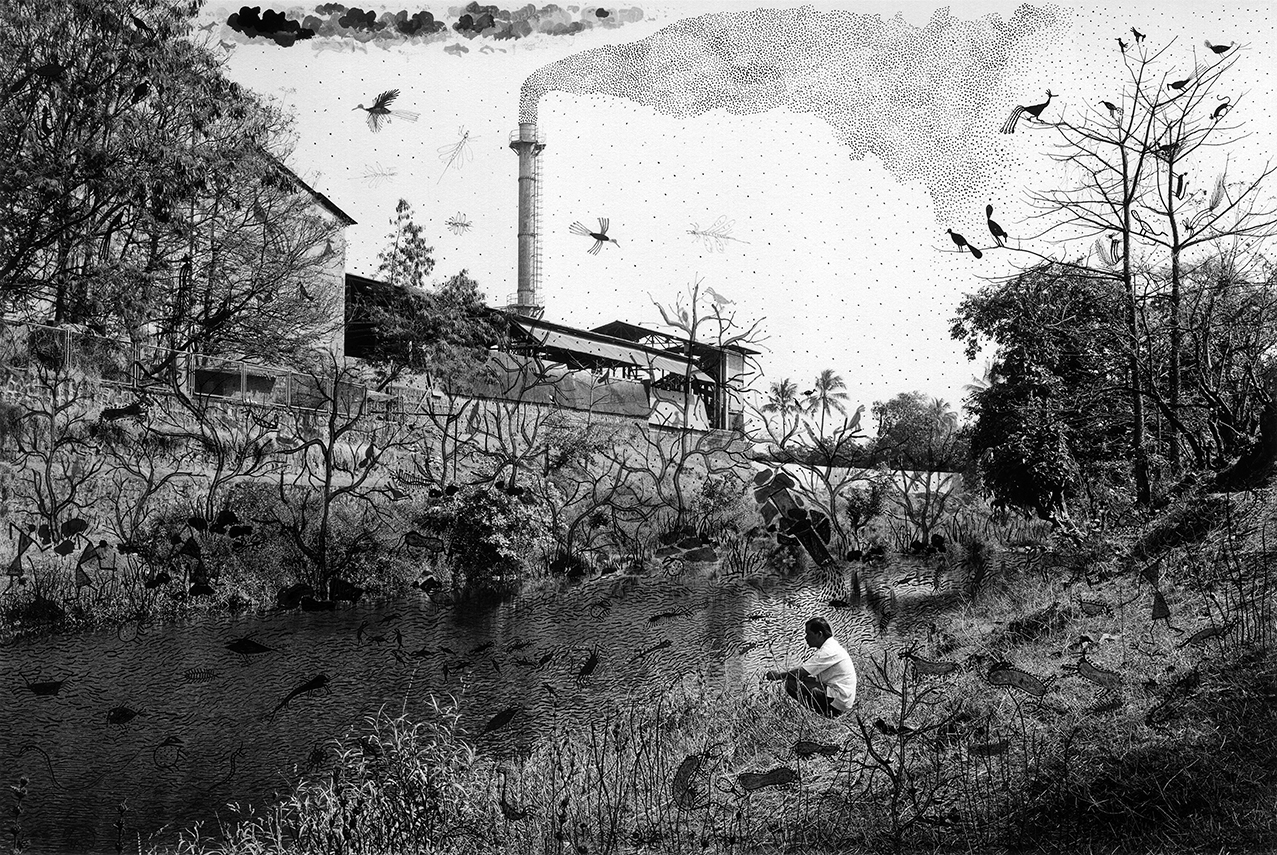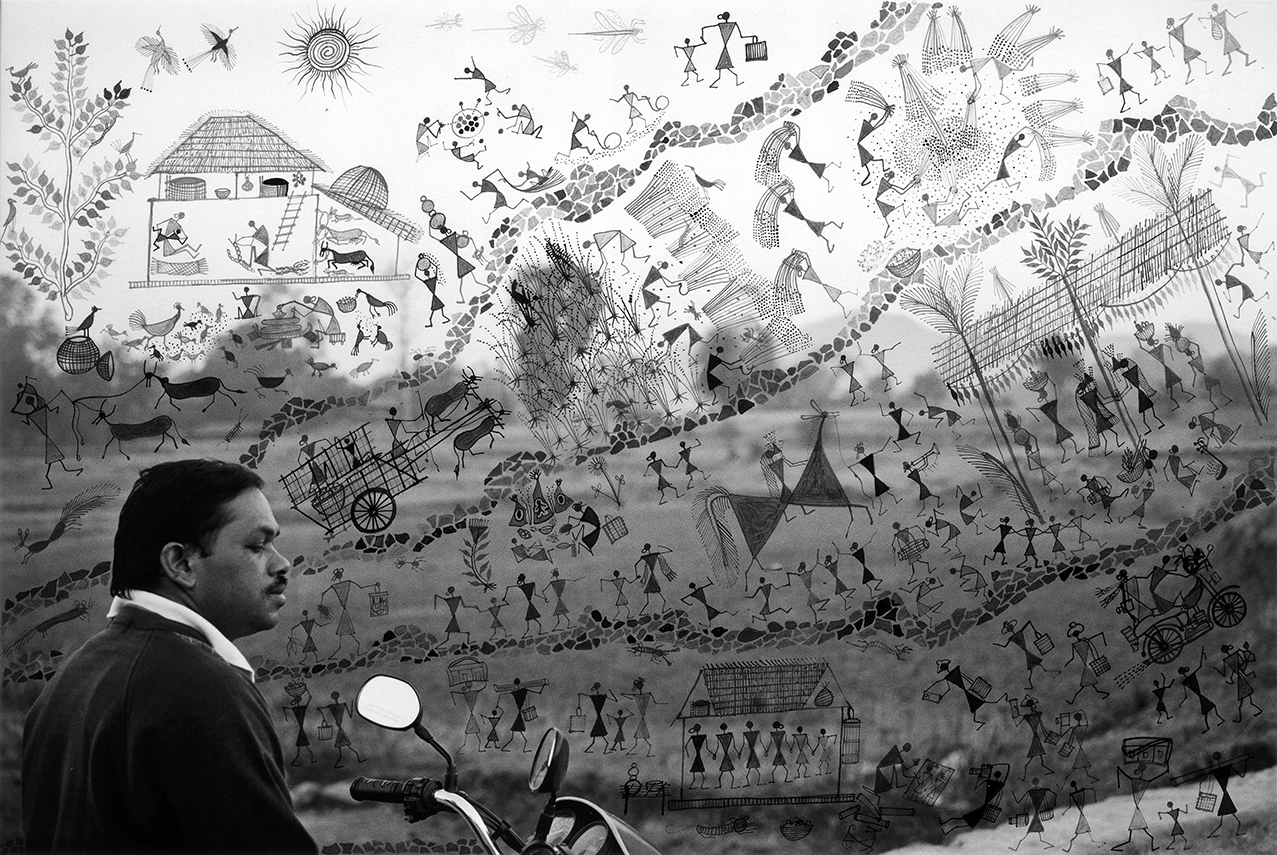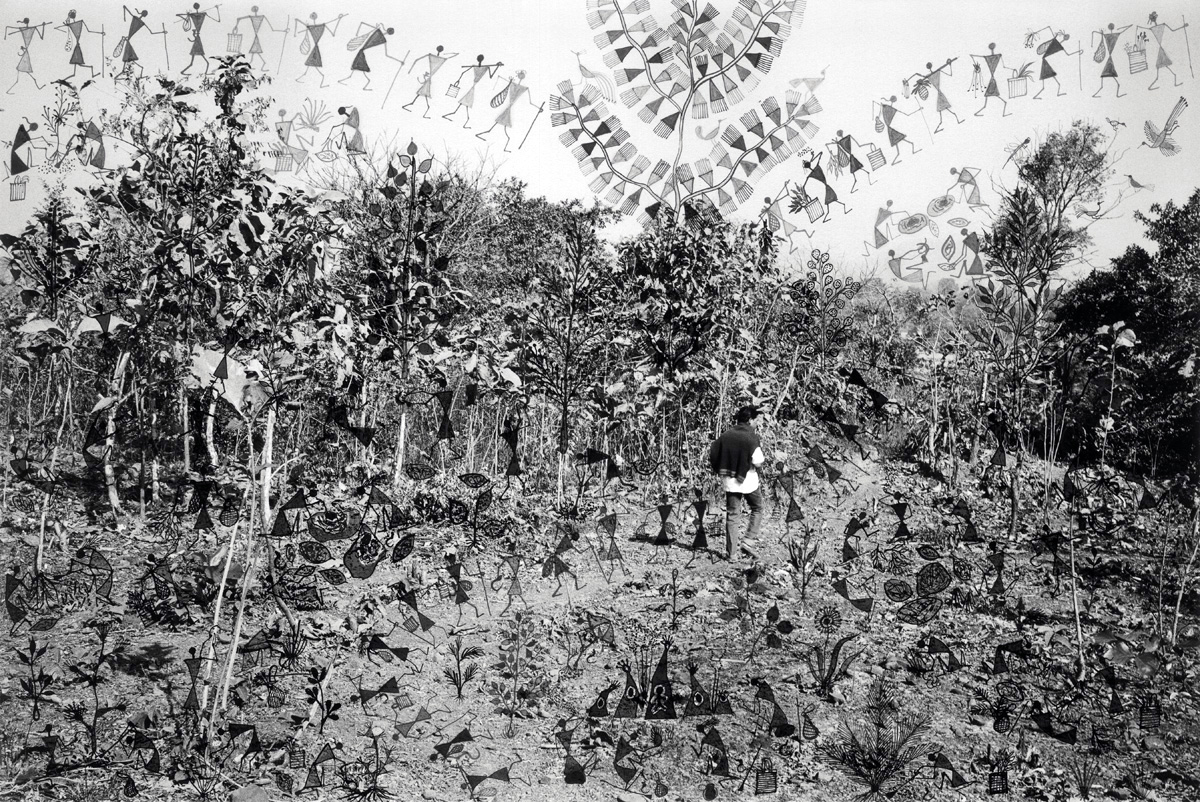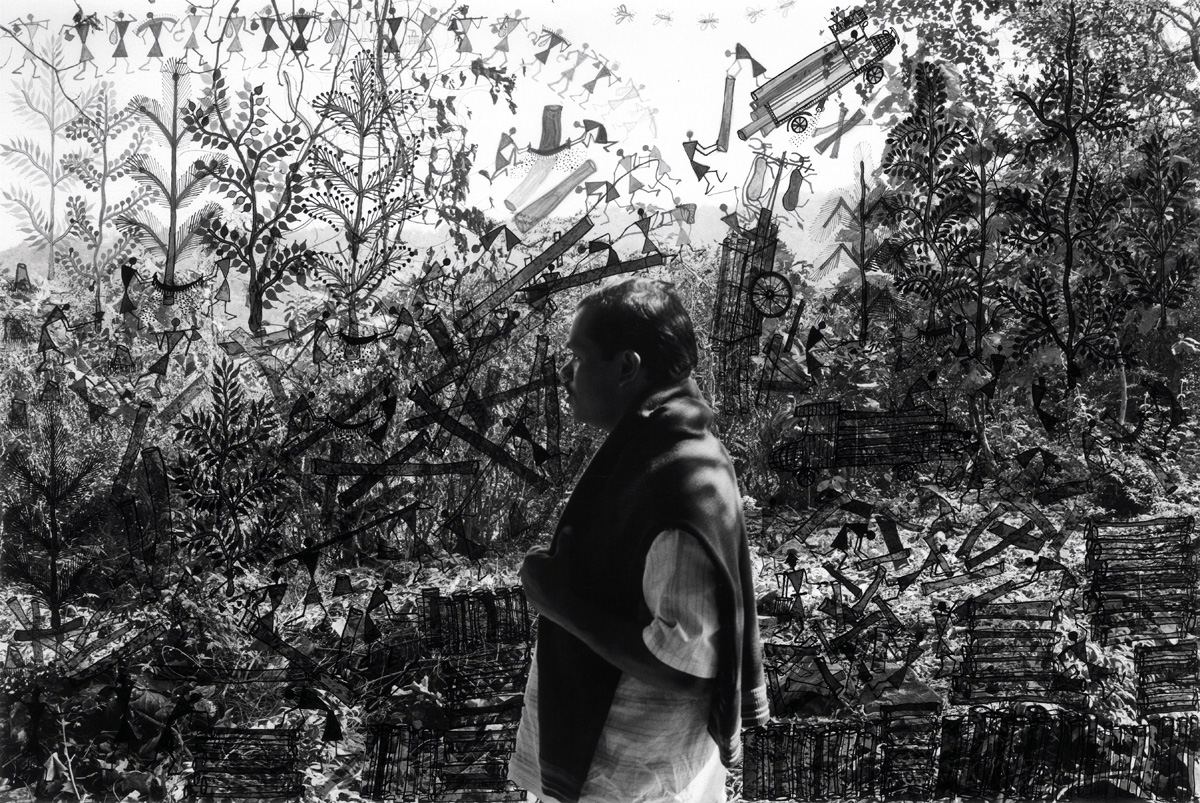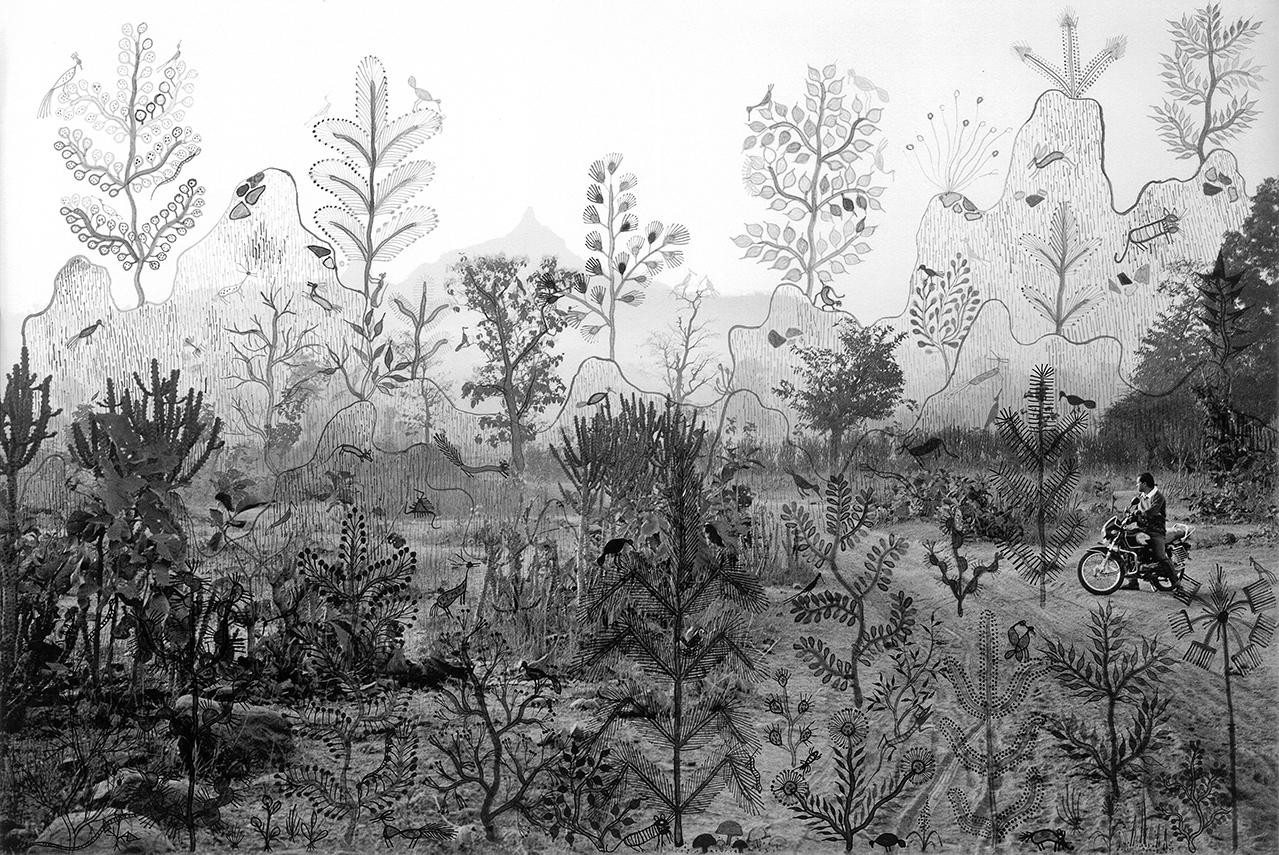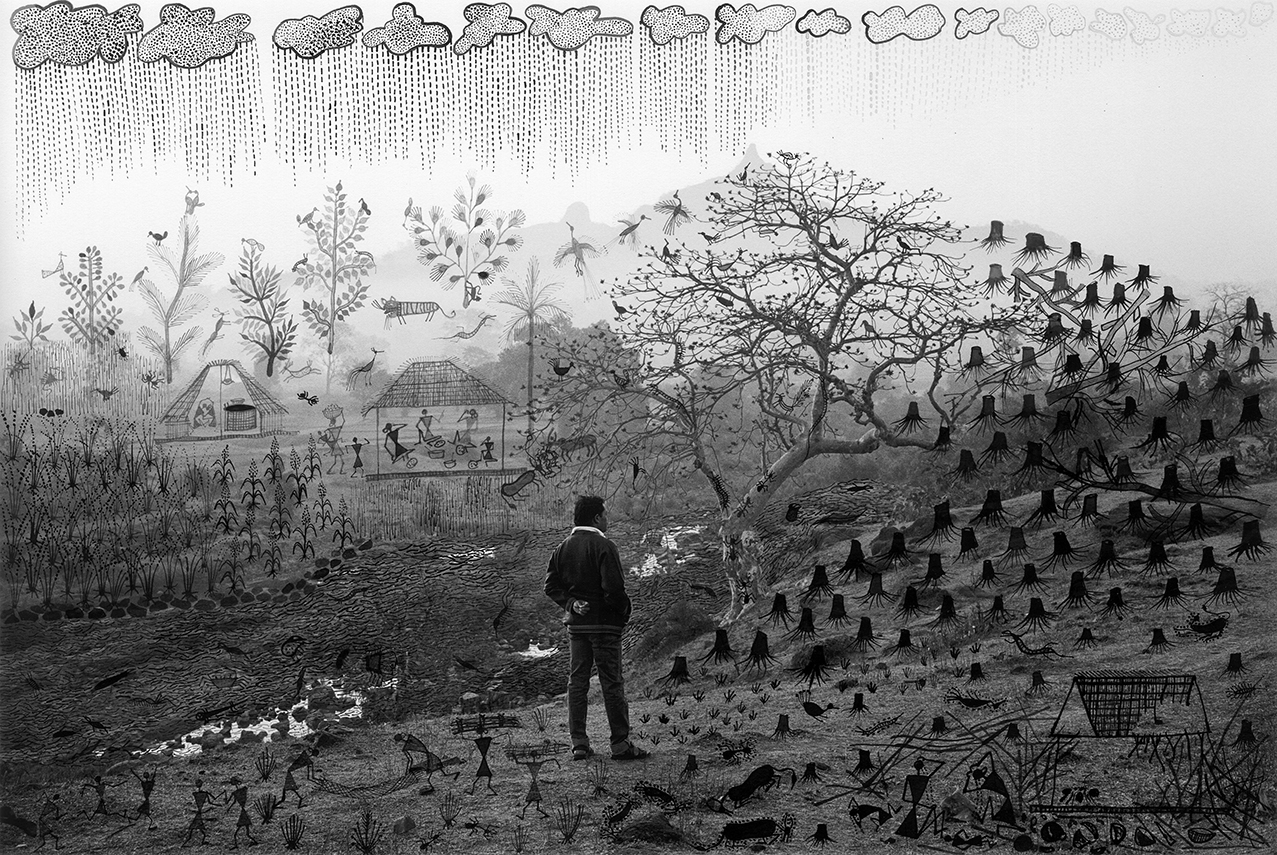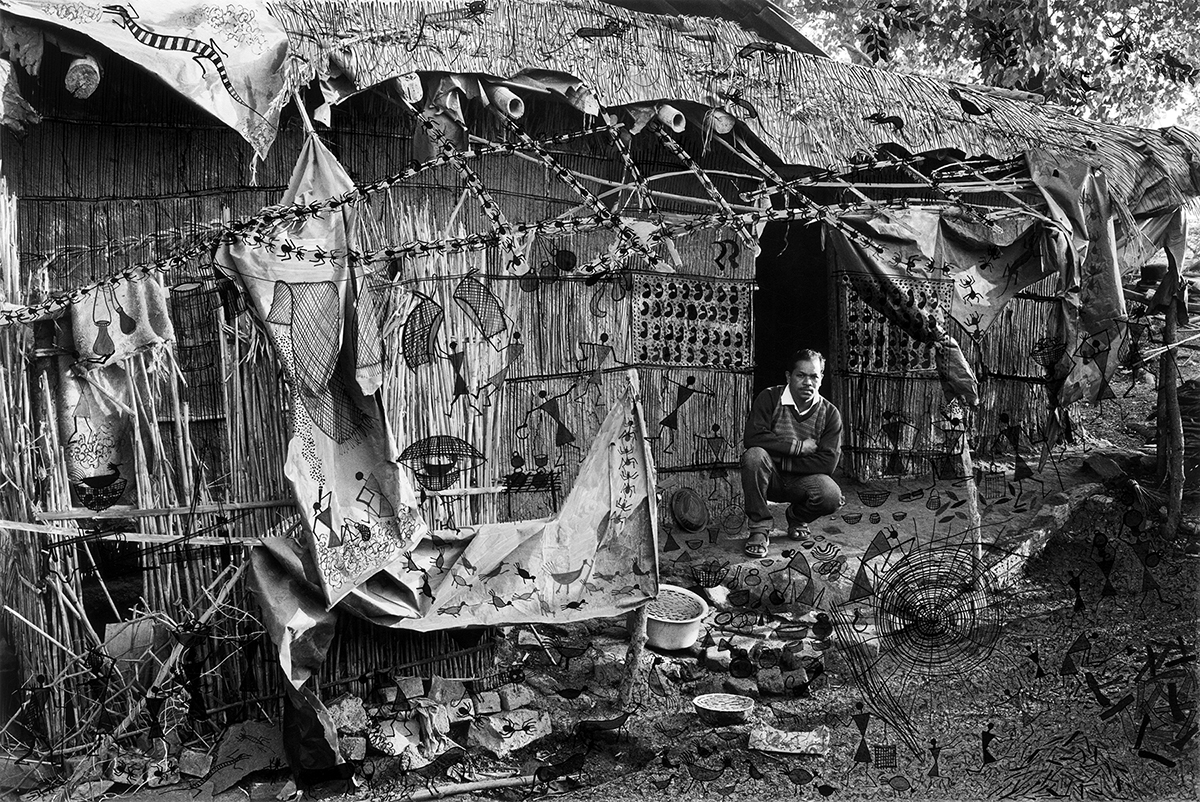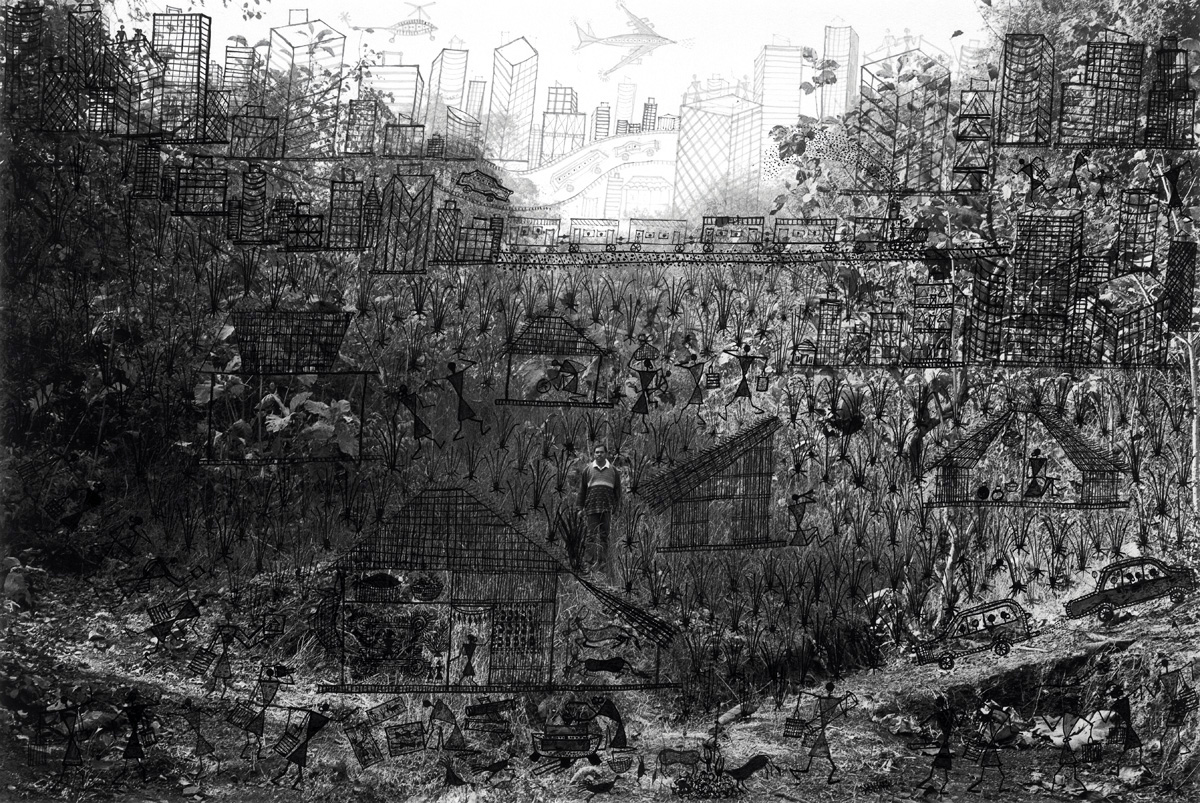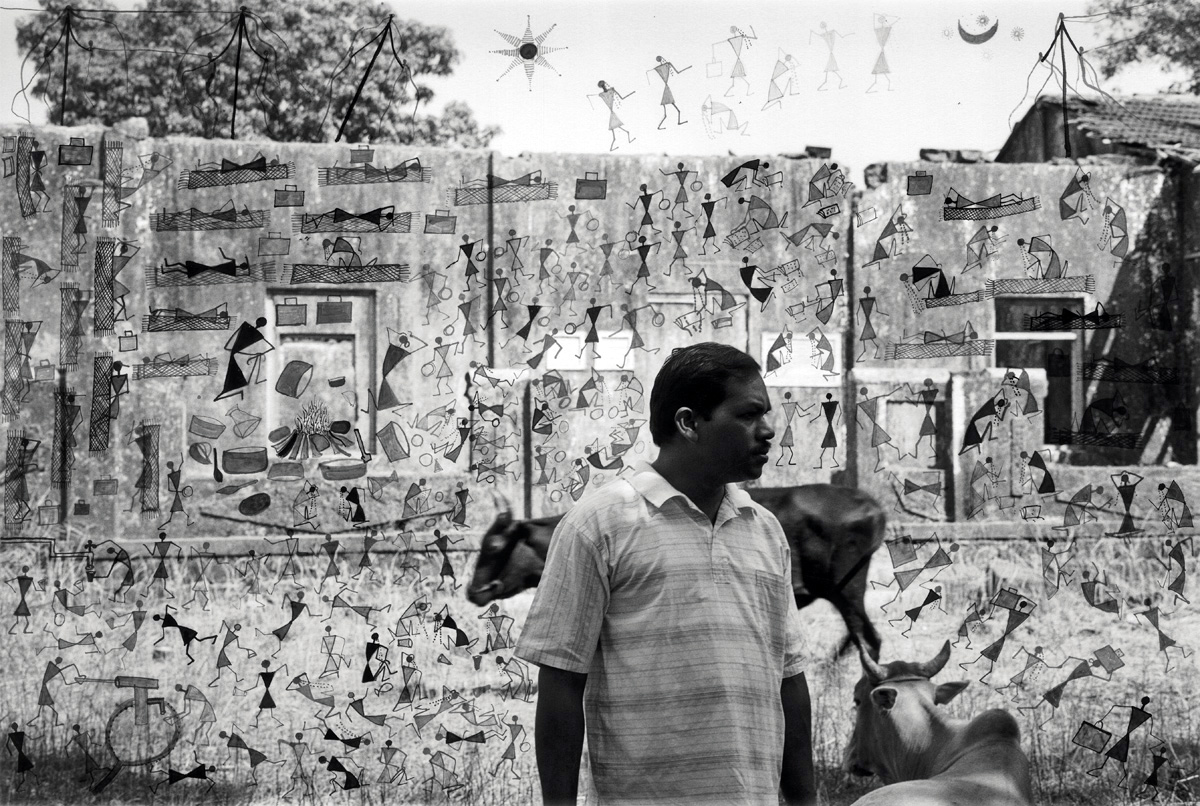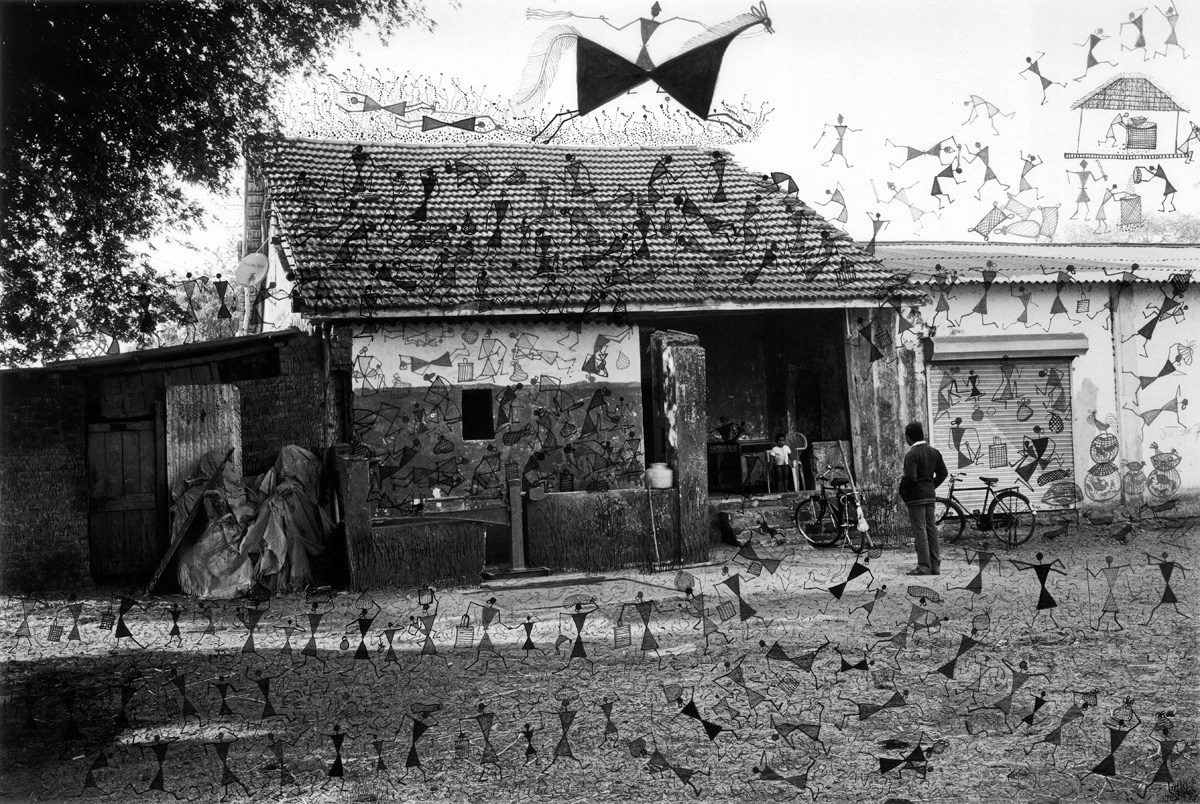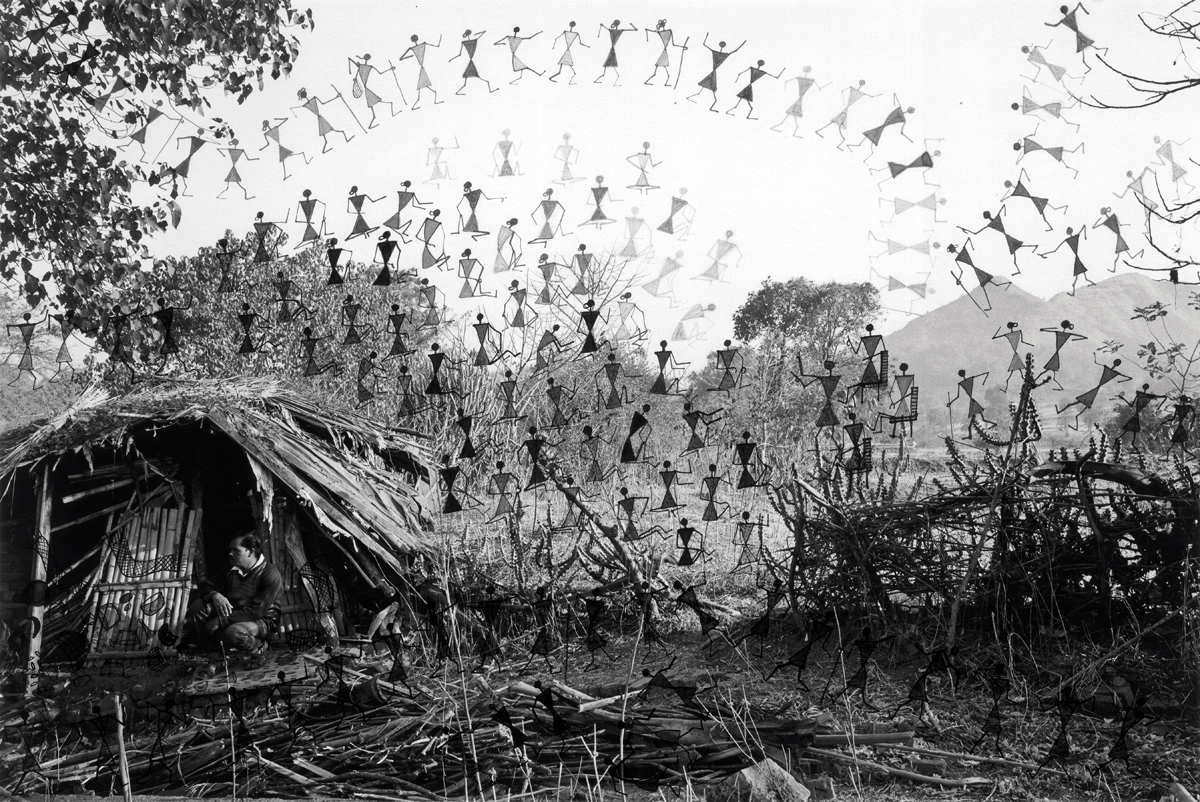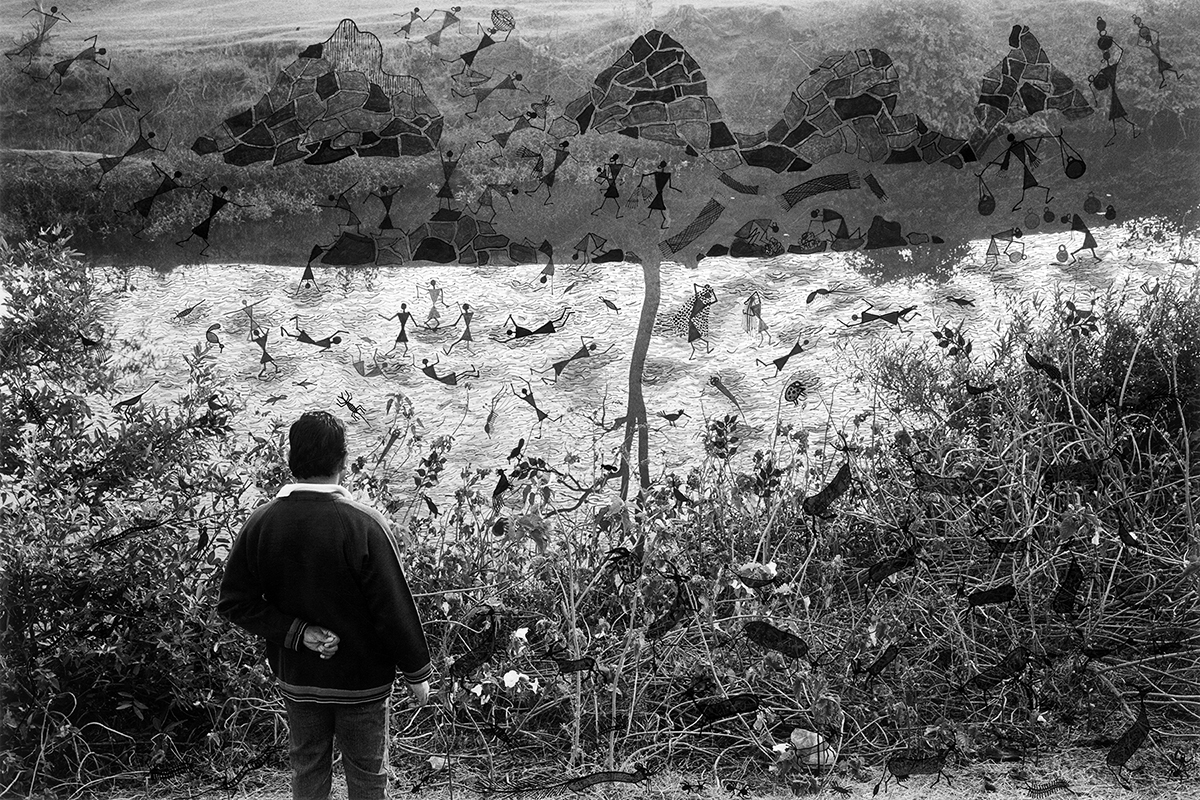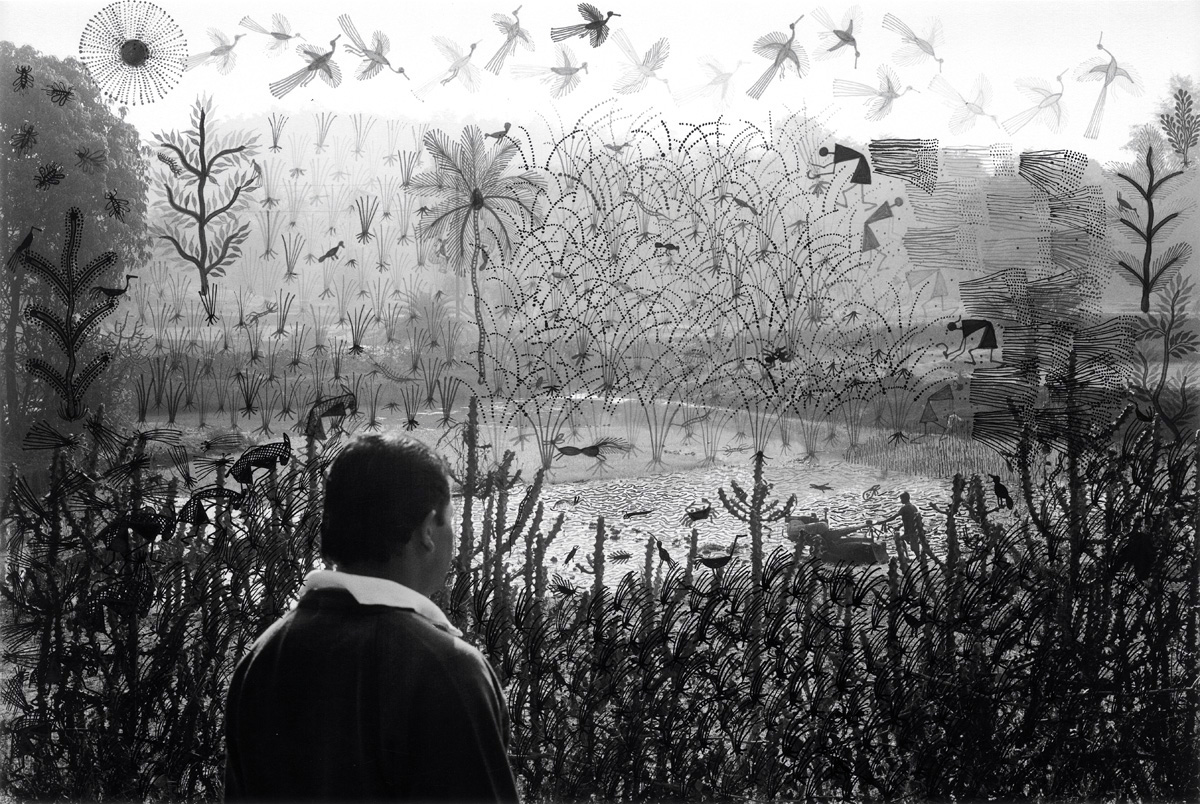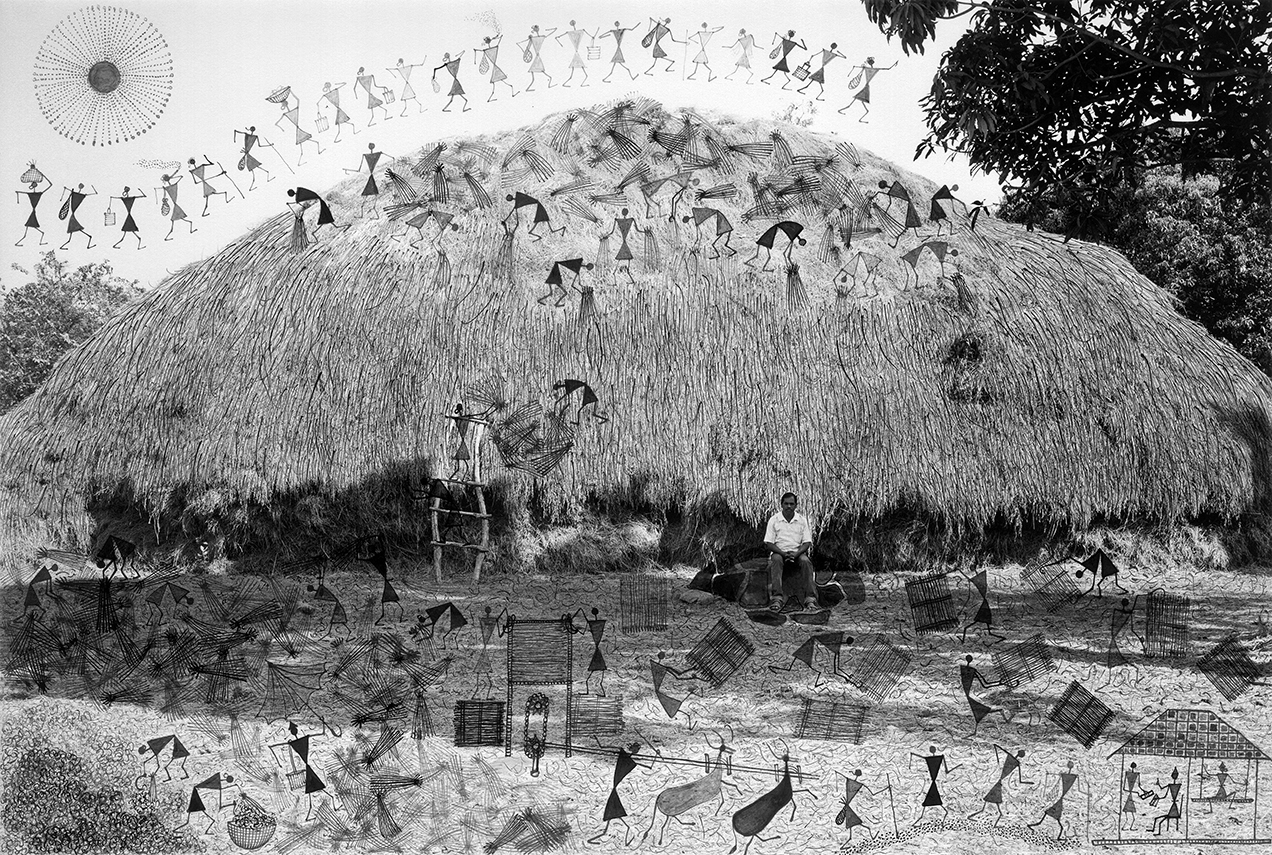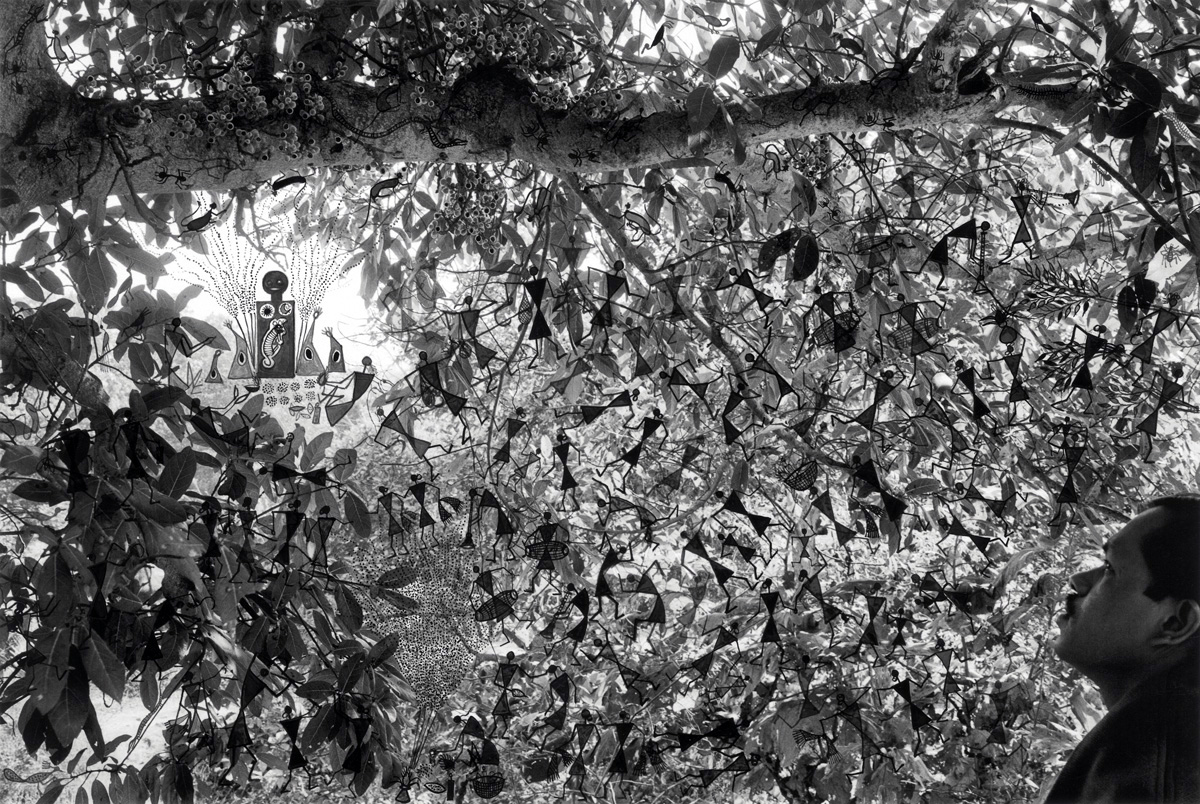Another Way of Seeing
Gauri Gill & Rajesh Vangad
Michael Collins
Only a two-hour drive from Mumbai but a world away from the metropolis, Ganjad is a small farming village nestled in the hills of northern Maharashtra’s coastal region. It’s a modest, vulnerable community with intermittent electricity, and you have to climb a hill to get telephone reception. The population are Warli, an indigenous, or Adivasi, people, who speak an unwritten language and are known for their folk paintings. Traditionally these were painted by women, using a paste made from flour and applied to dung walls inside their homes. Symbolic illustrations in stark white on an ochre background, they would commemorate special occasions such as weddings and harvests.
Warli paintings are no longer purely made for local village life; there is a mural by Rajesh Vangad, a celebrated Warli artist, at Mumbai airport. It was in Vangad’s family home that the photographer Gauri Gill stayed when she came to Ganjad early in 2013 to work with the local primary school. The family has lived there for generations, and Vangad is intimate with the place and its history. He knows the stories of the violent political mobs and underhanded land grabs, and what the fields are like at haymaking time, and how the forest looks under a full moon. The more Gill understood Vangad’s bond with the place, the more she could sense aspects of his life in particular locations. Her landscape photographs alone couldn’t convey what Vangad would see and recall in these places. So she placed him in her landscape photographs, composing them as settings for his reminiscences, and to give expression to these she asked him to draw over the prints, projecting his memories onto the pictures.
Gauri Gill
In early 2013, I spent some weeks in Ganjad in Dahanu – an Adivasi village in coastal Maharashtra. I was invited to live in the home of a well-respected artist, Rajesh Chaitya Vangad, and to create work in and for the local primary school.
In the course of my time living in Ganjad and working on the school project, I began to appreciate the landscape; only some hours away from Bombay, it was nonetheless completely distinct. We were living within nature, which, chameleon-like, had so many faces – changing even as one took a turn. There was no electricity for hours and nights altogether, and the Airtel only worked when you climbed a little hill.
Undistracted, one’s awareness was sharpened. I wished to extend this awareness through photographing the landscape, but it felt distant, even opaque. Perhaps the beauty was a barrier, or perhaps I had simply not spent enough time there. In conversations with Rajesh, whose family has lived for generations in Vangad Pada, working as artists, we began to discuss his village.
Any place looks entirely different to different eyes. I was made acutely aware, once again, of how a place is assigned meaning only by its viewer, determined perhaps by her relative distance or proximity to it; and of how viewing itself is an essentially solitary act, since what we see might be only a projection of what we know, have already seen or experienced prior. As someone wise once said, to one man’s eye the pond is full of beautiful lotuses to admire, to another man it contains mighty fish to eat.
Tentatively, I decided to photograph places significant to Rajesh – often with him present in the frame. He would take me to these special places, and I would decide where and how to construct the image, what to include within it, how to work with or against the light, how best to frame him within the landscape and so on. It was a set of pictures about his place, a map determined by Rajesh, and formally constructed by me – photographer as cartographer.
When I later saw my contact sheets, I realized that so much of the narrative that I had received from Rajesh – the great stories, which had made it come alive for me – was missing. Part of it, I realized, was the limitation – and perhaps, unique presence – of photography, which restricts what is in the image to ‘now’. How could I convey what happened in those months in the 1970s when the violent mobs of a powerful political party raided the village and the locals fled and fell upon each other in terror; or the particular full moon night in October when a great forest on one hill comes alive, and all the people who spend that night in the forest see shining eyes glitter around them, as even the most dangerous animals are benign when everything glows from the aura of the moon; or the stories of great overlords who come calling in secret to the homes of innocent, hospitable men, bringing gifts and drink and returning with deeds of land; or the mythical stories that encompass everything that has come or is yet to come.
So we decided to collaborate in a more active way. Rajesh would inscribe his drawing over my photograph, meet my text with his own. Or I would construct a photographic scene or set, in which he might stand and speak. Over the course of the last year, through works mailed back and forth between Delhi and Ganjad and subsequent meetings, we selected several photographs and worked on them to reflect the narratives that arose from our conversations. We restricted our work to a monochromatic palette to make the encounter more intense and precise. The final work was created over a period of thirty days spent together in my studio in Delhi, in two spells.
This commingling work may be seen as an encounter between two artists of about the same age with entirely different languages – one with ancient antecedents, the other more recently originated; and the histories, politics and world views embedded within the expression of those forms. Rajesh’s language, constructed with stick and brush, unfolds entirely from an encyclopedia of forms in the mind, which emerge to reflect the world, memory and myth: wind, disease, apocalypse – anything is summoned forth at will. In my own language, constructed by camera and negative, the world itself is the encyclopedia, and I recognize and edit existing structures to reflect what is apparent in my mind. The final work contains parallel projections of place; using perspective, negative and positive space, tonal values and relative dimensions, it merges fields of sight, and of perception. If you stand here, you might see it this way, if you move just a little, another world unfolds.
Rajesh Vangad
I am a creation of my stories, which live in my work. There are at least sixty stories I know. They concern gods, kings, man, the earth, Mahadeva, Parvati and the gods of the hills. This particular story was told to my father’s father by his brother. He relayed it to my father, who told it to me. I believe it was prescient, that it foretells the future. It encompasses so much of what we see today: earthquakes, cyclones, tsunamis and all kinds of destruction on earth. Why do we farm, when, and how, in how many days and in what ways must the farmer till his fields, all of this is in the stories. It manifests constantly in my work:
Once, there were four hunters. Each hunter came from a different direction and represented a different portion of the whole – North, South, East and West. Each one went to the forest to hunt. The hunters did not know each other and went there on their own. Hunting, they roamed from forest to forest, until they were in the deep. One day, in a clearing, the first hunter encountered the second and asked him, who are you? The second hunter answered: I am a hunter, from the South. The first hunter replied: I too am a hunter, from the North. The two decided that since they were both hunters, they would hunt together. Both continued their journey.
As they travelled, the two encountered the third. They asked him: who are you and where are you from? He replied: I am a hunter, from the East. They invited him to join them. And so they continued.
Like this days and nights passed. One day, they went to a big jungle to hunt. There they met the fourth hunter. In answer to their question of his antecedents, he replied: I am a hunter, from the West. The four decided to continue together, hunting as they moved deeper and deeper into the forest.
When they finally arrived in the very dense core of the jungle, they could not find anything to hunt for two full days. So they decided to find somewhere where there was water and the shade of a tree to rest. They spotted a large Bael tree, and a stream flowing nearby. As they went closer, they saw a hut near the tree. As they moved even closer, they saw a sadhu near the hut. They greeted him respectfully, and he asked them how it was that they had come to the deepest part of the jungle. One replied: We are hunters of four separate directions, and met while hunting; hunting together, we arrived here. They asked if they could spend the night in the hut. The sadhu answered in the affirmative. All four of them cooked some food, ate and slept.
In the morning, before the sun rose, the four went off in four different directions to do their morning ablutions. When the first hunter reached the river, before bathing he saw a cow give birth and eat its offspring immediately after. The first hunter was astonished at the sight.
The second hunter went in another direction, where he saw two large trees. Upon one he saw a beehive. Before he could begin to bathe he saw an elephant eat all the leaves of the tree only to discover his tail was now stuck fast to the hive. No matter what he did, he could not dislodge it. The second hunter was astonished at the sight.
The third hunter made his way to bathe, but before he could do so, he saw the large mountain before him begin to slowly melt into water. As dawn rose, he saw the immoveable mountain, with all the men, animals, trees and plants upon it, become water and flow into the river. The third hunter was astonished at the sight.
The fourth hunter, before bathing, saw before him a greater mountain, with men and animals, trees and plants, start to crumble from one side, even as it caught fire. As it was being destroyed various gods tried to stop it, but they were unable to do so. Finally, a god managed to halt the destruction with the point of a needle. The fourth hunter was astonished at the sight.
All four returned to the hut, and told each other what they had seen. When they arrived, the sadhu was praying to Mahadeva. The hunters decided not to hunt that day, and instead told the sadhu the full story when he had finished. When the first hunter relayed his sight, the sadhu replied: Don’t trust anyone in these times. When the second hunter relayed his sight, the sadhu replied: Even the strongest man is able to get snared by small things. Therefore, walk carefully. When the third hunter relayed his sight, the sadhu replied: The earth is at risk from wind and water. When the fourth hunter relayed his sight, the sadhu replied: On this earth there is very little truth to be found.

